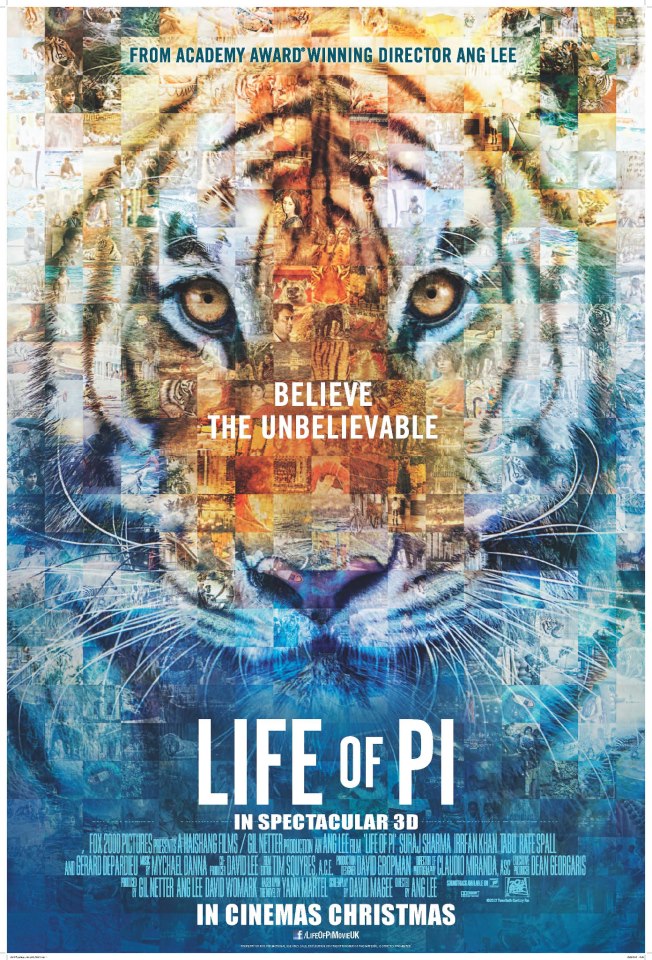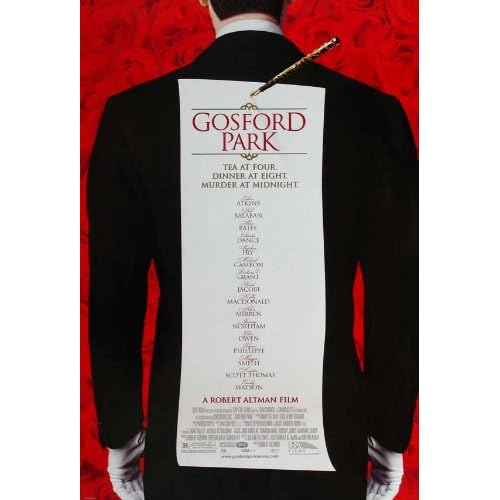

Director: Ang Lee, 2012 (PG)
Many had said that French-Canadaian author Yann Martel’s best-selling novel, “Life of Pi,” was unfilmable. It appeared that way until Ang Lee turned it into a spectacular movie last year. But the visual splendor isn’t quite supported by thematic integrity. The themes of faith and testing, of sin and surrender, and ultimately of story resound but ultimately in discordant fashion.
The movie opens with an older Pi (Irfan Khan) being visited
by an unnamed Writer (Rafe Spall). This man wants to hear Pi’s story, a story
he hopes will lead him to belief in God. And quite a story it is, although
whether he comes to faith is unclear. Cutting between flashbacks of the younger
Pi (Suraf Sharma) and his current self, Pi narrates a story for the ages.
The first act is set in Pondicherry in French-occupied
India. His father owns a zoo, and Pi learns first-hand about the wildness and
danger of the animals, especially a Bengal tiger strangely named Richard
Parker. But when they fall on hard times, his father determines to take his
family on a freighter across the Pacific to Canada where he will sell them and
make a fresh start.
At the end of the first act the freighter is struck by a
freak storm, and the ship goes under. Before it sinks, Pi is thrown into a
lifeboat where he eventually finds four animals as co-castaways: Richard Parker,
an orangutan, a zebra and a hyena. Fighting for survival among the high seas,
soon only Pi and Parker are left alive. Both wary of the other, they form an
uneasy coexistence for the 227 days that they are adrift.
Coexistence, particularly of faith, is an initial theme. In
India as a boy, Pi is raised a Hindu, the religion of his family. But through a
dare by his brother, he steals into a Catholic church to drink the holy water
and finds himself listening to the priest. In so doing, he becomes a Christian.
But his prayer to his Hindu God illustrates his syncretism: “Thank you, Vishnu,
for introducing me to Christ.” A little later he comes across a mosque and
adopts Islam as another religion, so these three coexist in his belief system.
Indeed, he declares, “Faith is a house with many rooms.”
Director Lee, in an interview with the late Roger Ebert,
commented: “I believe the thing we call faith or God is our emotional
attachment to the unknown. I’m Chinese; I believe in the Taoist Buddha. We
don’t talk about a deity, which is very much like this book; we’re not talking
about religion but God in the abstract sense, something to overpower you.” So,
in his view this faith on display is an abstract faith, in an abstract God, not
one specific and concrete, even personal.
But this idea of multiple faiths coexisting, or of all
faith-roads leading to the same God, is clearly wrong. Anyone who has explored
the tenets of these religions understands that they have contradictory
positions. They cannot be held together in tension. In fact, Jesus in his last meal before his
crucifixion, told his disciples, ““I am the way and the truth and the life. No
one comes to the Father except through me” (Jn. 14:6). This claim is quite
exclusive. Jesus did not say he is one way amongst many. He did not say people
may come to God through Vishnu or Buddha. No, he said he was the only and
unique way to come to God. True biblical faith cannot be compromised by
syncretistic worship or belief in other gods or ways. Lee is wrong. In fact, Pi’s
father, in an early scene, states a truth that is supposed to be negated by the
later narrative, but that actually underscores our biblical understanding:
“Believing in everything is the same as believing in nothing.”
Despite his faulty theology here, Lee’s film offers other
aspect or illustrations of faith, even for the Christian faith. The adult Pi,
reflecting back on his adventurous journey, comments on faith: “After all, you
cannot know the strength of your faith until it is tested.” And tested it was,
throughout the many months he was afloat with just the tiger as his wild
companion.
The New Testament writers spoke of faith’s testing. James
said, “Consider it pure joy, my brothers and sisters, whenever you face trials
of many kinds, because you know that the testing of your faith produces
perseverance” (Jas. 1:2-3). Paul said that “suffering produces perseverance”
(Rom. 5:3), and Pi’s testing, like ours, involved significant suffering. And
Peter talked of adding to faith a list of virtues that included perseverance
and ended in love (2 Pet. 1:5-7).
 The second act is the very heart of the story. Lee uses
computer generated imagery to create the tiger as well as other images that
form a veritable feast for the eyes. Indeed, the visual splendor is so sumptuous
that to some degree it detracts from the very story and its themes. It is a
film that bears seeing again, to catch the story elements.
The second act is the very heart of the story. Lee uses
computer generated imagery to create the tiger as well as other images that
form a veritable feast for the eyes. Indeed, the visual splendor is so sumptuous
that to some degree it detracts from the very story and its themes. It is a
film that bears seeing again, to catch the story elements.
Midway through this act, Pi finds himself and the lifeboat
aground on a magical island, a floating island that is populated by meerkats
and fresh-water lakes. Enjoying the wonder of this isle, Pi swims and drinks
until he is refreshed. But the island is fashioned in the shape of Vishnu or a
person. And as darkness descends, the island transforms into a carnivorous
creation, seeking to devour its inhabitants.
This island forms a metaphor for sin itself. Sin appears
attractive and appealing, winning us by tempting our desires, just as Satan
masquerades as an angel of light to deceive us (2 Cor. 11:14). But this masks
sin’s very deceitfulness (Heb. 3:13). And with the darkness comes the danger.
Sin emerges most clearly when the light is absent. This word picture of light
and darkness comes across most clearly in the epistle of John, where he declares,
“God is light; in him there is no darkness at all” (1 Jn. 1:5).
 In another scene in this second act, the lifeboat is tossed
around by the waves during a lightning storm. Pi stands, arms held high above
his head, and cries out to God, presumably Vishnu (as he laters says “Thank you
Lord Vishnu” for saving him), “What else do you want from me? I’ve surrendered
everything.”
In another scene in this second act, the lifeboat is tossed
around by the waves during a lightning storm. Pi stands, arms held high above
his head, and cries out to God, presumably Vishnu (as he laters says “Thank you
Lord Vishnu” for saving him), “What else do you want from me? I’ve surrendered
everything.”
Surrender is another biblical theme that is subsumed into
faith. The hymnist coined the phrase, “I surrender all” as an illustration of
the biblical concept of giving ourselves wholly over to God. In Christ we give
up our old lives to take on his new life, poured out through the Holy Spirit
into us. We ourselves cry out, “Thank you Lord Jesus Christ” as he is the one
who has actually saved us (2 Tim. 1:9).
In the third act, the rescued Pi finds himself in a hospital
bed. When he is visited by insurance agents trying to make sense of the
shipwreck, he recounts the story we have seen in act two. When he is finished,
they denounce it. So he tells them another story, essentially the same one but
devoid of God and animals, a faithless fable.
The prologue and the conclusion present contrasting views of humanity. Whereas the
Writer wanted to hear a story so he might believe in God, the two Insurance
Agents wanted to hear a rationalistic story, one without God since they do not
believe in him. This relates to how we tell our stories and the story of the
gospel. From a Christian perspective, we look at life through the spectacles of
faith and we see the hand of God at work in every area of our lives. We
recognize the presence of God everywhere (Acts 17:24). But those who refute
God, look at life through darkened lenses that obscure the patterns of God.
Where they might view him, their brains refuse to accept the evidence of a
deity. Instead, they seek after rationalistic interpretations of events. They
choose the godless story.
In the closing scene, Pi asks the Writer: “So, which story
do you prefer?” The Writer thinks and then answers with a smile, “The one with
the tiger. That’s the better story.” And Pi says, “Thank you. And so it goes
with God.”
Which story do you prefer in your life?
Copyright ©2013, Martin Baggs










 Exciting news! Mosaic's Movie Connect Group is alive!
Exciting news! Mosaic's Movie Connect Group is alive!




